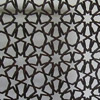Scientific publications are expected to relate to all areas of science they sprawl. For this, the scientific publication is associated with several keywords that are thought to be related. For proper access to scientific publications in literature research, keyword assignment is as important as the publication title. This study aimed to map the usage patterns of the concepts related to the field of digital design research through keyword analysis. The […]
Posts with the keyword computation
Here is a good brief explanation by Mark Garcia on how patterns re-emerged in the digital age after Modernism and Postmodernism. …In the 1980s and 1990s, Postmodernist patterns predominated, and especially those of Robert Venturi, Rem Koolhaas, Stan Allen and Sanford Kwinter (fields), along with historicist, folding, sprawl, cross-programming, high-density/proximity, non-places and other Deconstructivist and high-tech patterns. In 1992, Henri Lefebvre’s last book Rhythmanalysis: Space, Time and Everyday Life was […]
This was my first parametric patterning study we conducted together with Birgül Çolakoğlu at Yıldız Technical University in 2008. It was based on the pattern exercises we’ve experienced with BOT Graduate Students as a preliminary study within a Computational Design Studio. Later, the CNC fabrications were exhibited at İstanbul Bilgi University Digital Design Symposium. The exercise was about analyzing and reconstructing regular İslamic Patterns via MaxScript. After fundamental instructions about the […]
Below is another cult article written by Robert Aish in 2005; Design has been described as making inspire decisions with incomplete information. True, we may use prior knowledge, we may even think we understand the causalites involved, but what really matters is exploration: of new forms, of new materials, and speculation about the response to the resulting effects. Essentially, this exploration has its own dynamics, involving intuition and spontaneity, and […]
After explaining the beautiful parquet deformations of William Huff, Douglas Hofstadter states his opinions about the algorithmic potentials of those patterns. Although it was 30 years ago, Hofstadter points out a fundamental discussion related to today’s parametric design tools; …for a machine to make simple variants of a given design, it must possess an algorithm for making that design which has explicit parameters; those parameters are then modifiable, as with […]
In 2007, we conducted a computational design studio in YTU / CADU with Birgül Çolakoğlu. Below is the brief of the paper published at METU JFA Vol24 issue 2 titled “An Innovative Design Education Approach: Computational Design Teaching For Architecture”. We were dealing with how new technologies are affecting the design cycle. Rhinoscript is used as an educational tool, and various short exercises are conducted with it. After 6 years, […]
Studio exercises are short-term and open-ended design activities that represent a constructivist learning approach by limiting design domains. They are student-centered, model and process-oriented educational tools. These qualities make studio exercises potential tools for integrating contemporary Digital Design thinking into architectural education. This research aims to reveal these potentials by defining an analytical perspective and logical connections between the pedagogical intentions of studio exercises and the theory of Digital Design. […]
Whenever we try to define something suitable for our design intentions, it became somehow closely related to the design tool. The contemporary theory of computational design (or design computing) has many definitions. In this website, we look at that from the perspective of method and its theory underneath, not the tools; however, it finally comes to a point that we -again- start to talk about “tools”. Whatever, the purpose is […]











